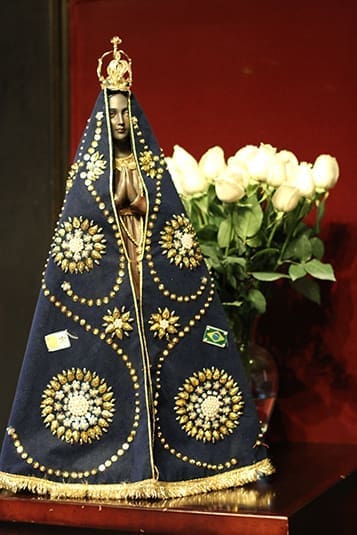Atlanta
Brazilians Are Devoted To Our Lady ‘Who Appeared’
By ANDREW NELSON, Staff Writer | Published October 25, 2012
The story of Our Lady Aparecida is about much more than fishermen looking for the day’s catch, although that’s where the devotion began.
“It is the biggest celebration in the Brazilian community,” Father Roger do Carmo Araujo said. Crowds fill St. Jude Church, Sandy Springs, for the occasion.
First the story behind the devotion, which is celebrated on Oct. 12.
In the early 18th century, fishermen in the town of Guarantinqueta were casting nets for hours in a river to provide food for an upcoming festival. The nets were coming back empty. And as the workers were about to give up, a net snagged the body of a statue. The next cast of the net brought in the head of the statue.
According to the story, the workers put together the statue, which was soon recognized as the Virgin Mary, under the appearance of the Immaculate Conception. More prayers were said, this time to ask for help from the Virgin Mary. And the nets came back bursting with fish.
This is seen as the first miracle of Our Lady “Aparecida.”
The statue is named Nossa Senhora da Conceição Aparecida (Our Lady of the Immaculate Conception Who Appeared). And it is found in the Basilica of Our Lady Aparecida in Brazil, near Sao Paulo. It is the largest Marian shrine in the world.
Hope and faith are two lessons from this appearance of Our Lady.
Father Araujo, who serves the Brazilian community in the Archdiocese of Atlanta, said the workers held their faith when the odds were against them.
“They believed in a difficult situation,” he said.
Many people today face difficult situations, perhaps being out of work or problems at home, but Our Lady Aparecida shows how people’s faith can guide them through turmoil, he said.
Our Lady Aparecida also carries a message of hope.
Father Araujo said when times seem hopeless, prayer and God can turn things around.
“It is possible to make a better situation,” Father Araujo said. “All problems have solutions.”
There’s a bit of mystery around the statue. The image was made around 1650, believed to be the work of a monk, Frei Agostino de Jesus, who created clay sculptures, but it’s not known how the statue got dumped in the river. The image is dark brown and covered by an embroidered cloth, covering everything but the face and hands. A crown of precious stones sits on its head.
Brazilians, who make up the largest Catholic country in the world, embrace the feast day as a point of national pride. They celebrate Our Lady, who has been their national patroness since 1930. Pope John Paul II visited the shrine to Our Lady Aparecida and gave it the title of a basilica.

A statue of the Our Lady of Aparecida, which is depicted as a dark-skinned image of the Virgin Mary, is on display in the narthex of St. Jude the Apostle Church, Sandy Springs, before the 2011 feast day Mass.
Our Lady Aparecida: Patroness Of Brazil
- Fisherman discovered Our Lady Aparecida in 1717 in a river. The head was broken from the body. It is reported to have been made around 1650. It is not known how the statue got dumped in the river.
- The statue is dark brown. Since 1904, it has been crowned with precious stones. A cloth covers the statue, making only the face and hands visible.
- In 1930, Our Lady Aparecida was named the patroness of Brazil. Her feast day is on Oct. 12 and is a national holiday.
- In the 1980s, vandals stole the statue from the basilica. It was broken, but artisans were able to reconstruct the small statue.
- The Basilica of Our Lady Aparecida in Brazil is the largest Marian shrine in the world, visited by about 7 million people a year. It is the second largest church in the world, second only to St. Peter’s Basilica in Rome.